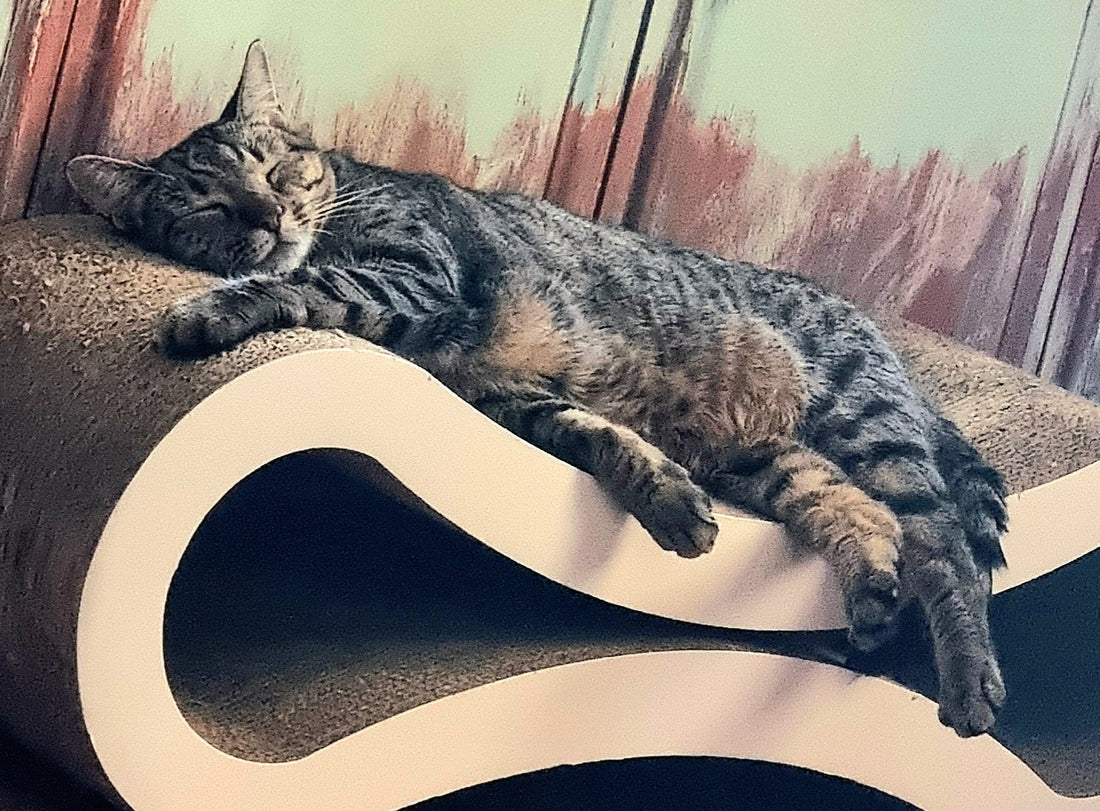
When grown or almost-grown cats knead, is it a memory of contentment when they used the same motions nursing that they are bringing up?
Share

'Sweet Cleo in La La Land' [Image by Hadinet Tekie]
Why Do Grown Cats Knead? Exploring the Heartfelt Memories Behind Their Gentle Motions
For many cat lovers, witnessing their feline friends knead is a heart-warming scene. You might have noticed your mature or almost-grown cat pressing their paws rhythmically against your lap or a cosy blanket — sometimes even with their eyes half-closed in pure bliss. But have you ever wondered why adult cats continue this behaviour? Is it just a quirky habit, or is there a deeper, sentimental story behind those gentle kneads? Join me as we dive into the fascinating world of feline kneading, enriched with personal stories, insights, and a sprinkle of feline science, to understand what your cat’s kneading truly means.

'Kneading session in progress' [Image by Kinship]
Kneading is that adorable, rhythmic motion where cats push their paws in and out against soft surfaces — like your lap, a pillow, or even your arm. This behaviour often begins in kittenhood, when they knead their mother’s belly to stimulate milk flow. As they grow, many cats carry this instinct into adulthood, often performing it with more grace and less urgency.
Cat behaviour expert Dr John Bradshaw explains, “Kneading is a comforting ritual that likely originates from their early kitten days, but it also serves as a way for cats to mark their territory with scent glands located on their paws.”
- The connection between nursing memories and adult kneading
Some feline enthusiasts believe that kneading in grown cats is a sweet reminder of their nursing days. The gentle pressing motions mimic the way kittens nurse from their mothers, bringing a sense of contentment and security. When your cat kneads, especially on you, it could be a signal that they’re feeling safe, loved, and relaxed — reverting to a time when they felt most secure as tiny, nursing kittens.
Think of it as a form of mental and emotional comfort, a way for your cat to reconnect with a time when they felt most loved and protected.
Personal stories from Kyro and Cleo
Let me introduce you to Kyro and Cleo, two of my beloved cats whose kneading habits tell stories of their unique personalities and histories.

'Adorable Kyro in one of his favourite spots in the house' [Image by Hadinet Tekie]
Kyro’s Journey
Kyro started kneading when he was just a kitten. Now, at just over two years old, he still kneads on me to this day. I remember the first time I saw him knead — his tiny paws pressing into my lap, eyes half-closed in utter serenity. It was as if he was not just seeking comfort but also showing his love in the only way he knew — by returning to that early, nurturing instinct. To Kyro, kneading isn’t just a habit; it’s a silent love letter.

'Beautiful Cleo is ready for her royal photo shoot.' [Image taken by Hadinet Tekie]
Cleo’s Calm Ritual
Cleo, a gentle feline with a quiet, elegant demeanour. She began kneading as a kitten. What’s special about Cleo is her ability to knead whenever she’s most relaxed — on my chest during lazy Sunday mornings or on her favourite blanket. She often looks up at me with soft eyes, her paws rhythmically working as if she’s reminiscing about her kittenhood, when nursing brought her comfort. Her kneading feels less about marking territory and more about embracing her inner peace — an adorable reminder of her contentment.
Scientific insights into feline kneading
Research suggests that kneading is a behaviour rooted in early development, but its significance persists into adulthood. According to animal behaviourists, kneading serves several purposes:
- Marking territory: Cats have scent glands on their paws, leaving their scent on the surface they knead.
- Comfort and stress relief: Kneading releases endorphins, making cats feel calm and happy.
- Preparation of a resting spot: In the wild, it is helpful to flatten grass or leaves to create a comfortable area for a nap.
Interestingly, statistics show that over 85% of domestic cats display kneading behaviour at some point during their lives, indicating its importance in feline emotional health and communication.

'Hard at work' [Image by GoodRx]
How to interpret your cat’s kneading behaviour
If your cat kneads you, it’s generally a sign of love and trust. However, understanding the context can help you interpret their mood:
- Relaxed and happy: Kneading on your lap with eyes half-closed
- Seeking comfort: Kneading when they’re anxious or in unfamiliar surroundings
- Territorial marking: Kneading on furniture or cosy spots to leave scent
Remember, if their nails are sharp, gently trimming them can keep the kneading experience pleasant for both of you. If your cat kneads excessively or in stressful situations, it may be helpful to provide alternative calming activities or consult with a veterinarian.
A gentle reminder
While kneading is a beautiful and natural behaviour, it's essential to appreciate each cat's unique personality. Some cats may knead more than others, and some may prefer to do so only in certain situations. Always respect your feline friend’s boundaries, and enjoy these tender moments as a sign of their love and comfort. Remember, every cat is special, and their behaviours, including kneading, carry heartfelt stories that deepen our bond.
As cat lovers, our journeys with these furry companions are filled with learning and laughter. Embrace their quirks and cherish the comforting rituals that remind us of their trust and affection.
 'Safe and loved' [Image by Hepper]
'Safe and loved' [Image by Hepper]
Whether it’s a nostalgic reminder of nursing or simply a way for cats to express their contentment, kneading is a touching behaviour that connects us to their early days of nurturing and affection. Kyro’s gentle paws and Cleo’s rhythmic presses are more than habits — they’re a language of love that transcends words. So next time your adult cat kneads, take a moment to appreciate the sweet memories and the deep trust behind those soft presses.
Happy petting, and may your cats’ kneading bring you as much warmth as it does them!
Warm Disclaimer: Please remember that the thoughts, experiences, and advice shared in this article are based on my journey as a cat owner with Kyro and Cleo in our London home. Every cat is an individual with unique preferences and a distinct personality. What worked wonders for my two might need some tweaking for your furry companions. Always observe your cat's behaviour, be patient, and consult with a veterinarian or a certified cat behaviourist if you're facing significant challenges or have concerns about your cat's health or behaviour. Happy kneading!


1 comment
Good tips and information on kneading this will be a great help to know when my new kitty comes along